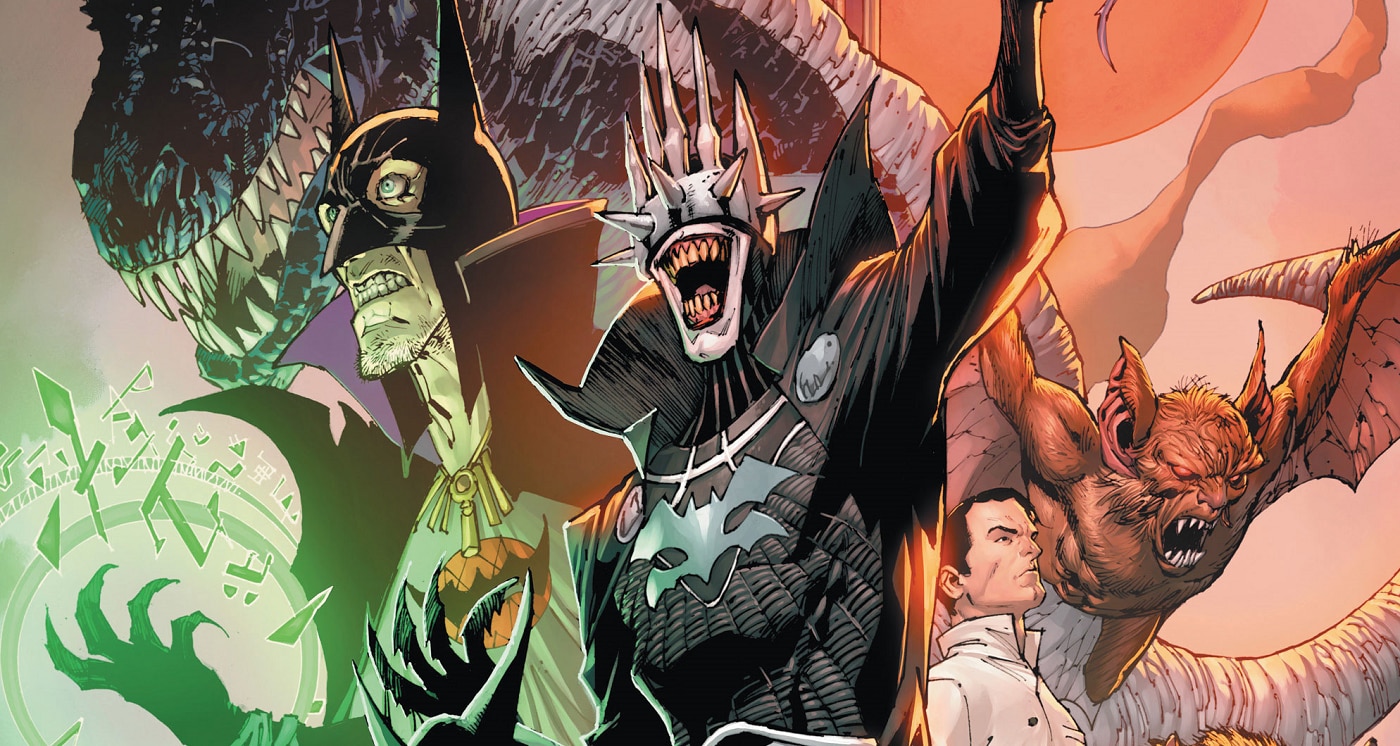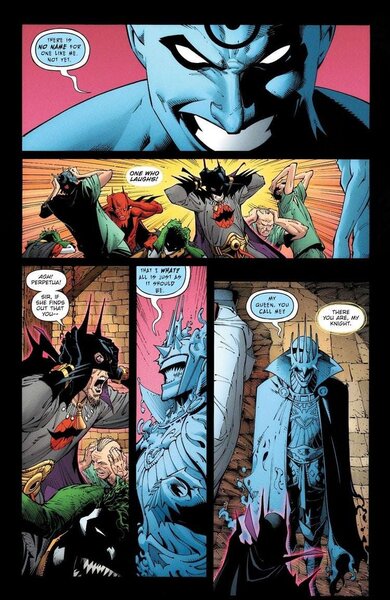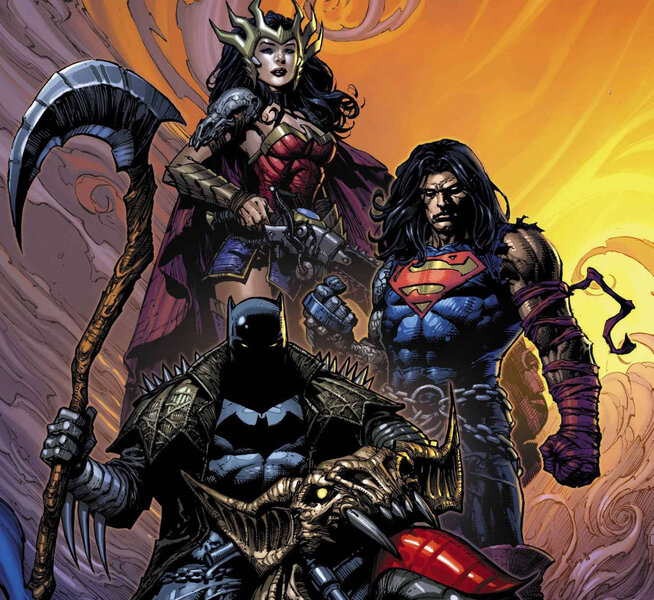Create a free profile to get unlimited access to exclusive videos, sweepstakes, and more!
Why Dark Nights: Death Metal is the ultimate 'What If?' story for Batman fans

The “What If?” trope is a handy tool in the storyteller's utility belt, giving creators an exciting way to jump-start a story simply by placing characters in a strange or unique setting and seeing what the answer to that enticing question is. Superhero comics are full of tantalizing “What If?” tales, but DC’s Dark Nights: Metal and Dark Nights: Death Metal, which pit the Justice League and the Caped Crusader against alternate, evil versions of Batman, are prime examples of just how well this trope can work.
As one of the most storied comic characters of all time, Batman has plenty of “What If?” tales and alternate versions in his history. What Scott Snyder and Greg Capullo's Dark Nights: Metal and Death Metal do so well is build on some of the most tantalizing, longstanding “What Ifs” the Dark Knight has ever had — and then make them canon to devastating effect. Snyder and Capullo give us updated iterations of previous, godly reimaginings of Batman, like Bat God, a version of Batman who had the power of Anubis, the god of death, in Doug Moench and Barry Kitson’s 1999 Batman: Book of the Dead. In 2015, Geoff Johns gave Batman omniscient powers in Darkseid War, which saw Batman sitting atop the Mobius Chair and becoming the god of wisdom for a short stint.
Barbatos — a guardian of the dark multiverse who appeared as a different mysterious Bat God figure during 2017’s Dark Nights: Metal — is arguably more deeply woven into the lore than either earlier examples, as his connection to Batman dates back to the beginning of time on Earth. But, the end of Metal saw Barbatos dethroned, and a new “What If?” version of the Caped Crusader, The Batman Who Laughs, taking up his mantle. In Death Metal, Snyder is revisiting the god concept with the Darkest Knight as the metal Bat God 2.0, as The Batman Who Laughs, an alternate version of Batman with the Joker’s sadistic madness, acquires the near-omnipotent powers of Watchmen’s Dr. Manhattan. The ultimate alternate Batman with ultimate power — it’s perhaps the most extreme “What If?” DC Comics has ever posited, and it’s all real within the main comics canon.
Granted, Snyder and Capullo did have quite a bit of space, time, and creative freedom to build out their story in the comics. Book of the Dead was a non-canon limited series that only ran for one year, while Darkseid War only obliged our “what if Batman was a god?” obsession for a few short issues. Dark Nights: Metal was not a limited edition run. It was meant to be canon. That’s exciting, not just for fans who follow the complex details of DC’s fantastic history, but also for the casual reader. Batman is, along with Superman and Wonder Woman, one of DC’s “Big Three.” With Barbatos, and the Darkest Knight, Snyder and Capullo get to fully explore the ramifications of such a powerful “What If?”
Synder cleverly uses other established parts of the Dark Nights mythos to set up some of Batman’s worst fears, giving us the first set of nightmare Batmen in the process, each their own example of a “What If?" We are introduced to the Batman Who Laughs along with six other incarnations from other dark universes. The Batman Who Laughs represents a particularly dark fear (arguably his darkest) for our Caped Crusader; the power of Batman, guided by the Joker’s insane philosophy.
Batman has faced many dangerous villains throughout his career but the Joker was always Batman’s most deadly and personal foe. He killed Jason Todd and paralyzed Barbara Gordon. He’ caused Batman and Gotham such misery that readers have often wondered why Batman doesn’t finally just kill him. What if Batman didn’t let the Joker live to hurt other people another day? Elseworld, non-canon comics have explored this possibility, and Alan Moore’s The Killing Joke teased the possibility with the graphic novel’s ambiguous ending. Yet, Batman continued to be driven by his code — and that’s ironically what causes these dark malfunctions in the Metal comics.
Snyder describes it as Batman virtually drawing light from other universes by choosing to be upright at all times despite the crisis. What results is a world wherein Batman actually kills the Joker and is infected by the Joker's deadliest venom, warping his sanity and turning him into the Batman Who Laughs. The Batman Who Laughs is eventually recruited by Barbatos, along with a team of six other dark multiverse Batmen. Here, Snyder shows us exactly what happens in a world where Batman is devoid of a code; he becomes the greatest evil and breaks the world with darkness. The “What Ifs?” in these comic events seem to germinate in fear itself, which is fitting for a character who enforces law through fear. Many other Dark Knight “What Ifs?” manifest as the event gives us Batmen we would never want to exist. And, as an added “What If?” bonus for readers, Metal doesn’t just give us a glimpse of these nightmare Batmen, it pulls them into the main reality and has a showdown between each Batman and a member of the Justice League, granting that ultimate “what if Batman fought the Justice League?” fantasy we’ve all harbored.
Death Metal isn’t over, so there may be greater horrors that have yet to be revealed, but so far the series is a demonstration of just how far the “What If?” trope can take a story — and how good that story can truly become.
















